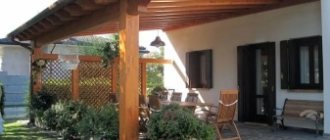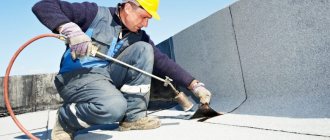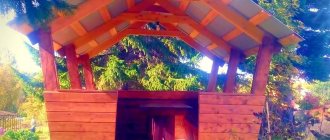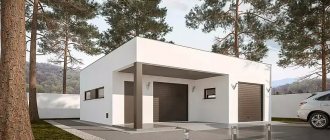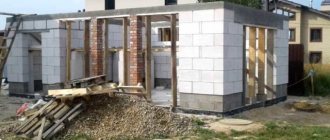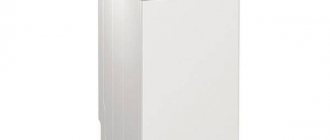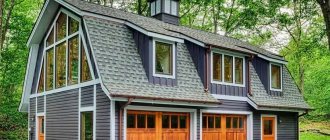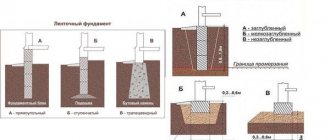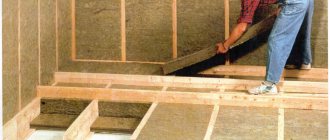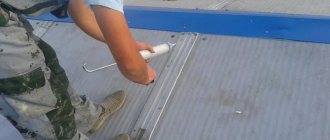It is advisable not to skimp on such an important structural element of a residential building as the roof. Therefore, when choosing which roof is cheaper - gable or hipped, you need to compare other parameters: reliability, resistance to wind and snow loads, the ability to use the under-roof space, compliance with the overall design of the house. And in the case of self-construction, there is also the opportunity to independently design, calculate loads and develop components of the rafter system.
Complex roofs require accurate calculations and well-written drawings Source sketchfab.com
Asbestos cement slate
This is perhaps the most famous roofing material. Each of us has at least once seen gray 8-wave sheets made from a mixture of asbestos, cement and water. In Soviet times, slate was used everywhere. He is not forgotten even now. Its first and main advantage is its low cost (only 200-450 rubles/m²). It is also worth noting that it is wear-resistant, non-flammable and resistant to ultraviolet radiation.
Unfortunately, there are also many shortcomings. Slate is quite heavy - about 10-15 kg/m², and this creates problems during transportation and installation. In addition, this material is susceptible to splitting. Any relatively heavy object (for example, a broken tree limb), falling on the roof, leads to the formation of cracks and even through holes. And sometimes a strong hail is enough for this.
Another disadvantage is that the rough surface retains water and dirt, which leads to moss growth. And finally, the environmental safety of the material raises reasonable doubts. The debate about how harmful asbestos is and whether it can even be used in construction has been going on for a long time, and there is no clear answer yet. But in most European countries, asbestos-cement slate is prohibited, which in itself is a fairly strong argument against.
To give slate an attractive appearance and extend its service life, manufacturers paint it by mixing silicate dyes into the raw material.
In addition to traditional wavy slate, there is also flat slate. It can be pressed or unpressed. And the first one outperforms the second one in all respects: it is denser, more durable and more resistant to temperature changes. Pressed material can withstand about 50 freeze-thaw cycles, while unpressed material can withstand about 25.
But no matter what the slate is, it is laid overlapping, nailed to the sheathing beams. For reliable protection against moisture, waterproofing is necessary. Typically, glassine or roofing material is used for these purposes, which will be discussed below.
2
Roof tiles
Natural ceramic tiles are one of the popular types of roofing for a country house. It is made from special clay using the tape or stamping method with further firing.
Roof tiles
Advantages of tiles:
- Low thermal conductivity;
- Frost resistance;
- The roof has high sound insulation;
- Good maintainability;
- Waterproofing;
- Inertness to biological and chemical influences;
- UV resistance.
Tile roof
The disadvantages of this material include:
- Its heavy weight;
- Fragility.
The high cost can also be considered a disadvantage of tiles - from 500 rubles per m²
Ruberoid
Another popular cheap material - roofing felt - is cardboard, impregnated with bitumen on both sides and protected with a coating of talc, asbestos, sand, etc. It’s probably not worth considering it as a covering for a residential building, but for technical buildings, summer kitchens, sheds, etc. he is quite suitable. Roofing felt is quite inexpensive - only 200-400 rubles. for a canvas 1 m wide and 10 m long. It protects well from moisture and is easy to work with, but that’s where the advantages end.
The main disadvantage of roofing felt is its fragility. The cardboard that forms the basis of the material is easily torn, so it can be damaged during the installation process. True, the hole can be easily repaired by applying a patch of the same roofing material or filling it with a layer of liquid bitumen.
But in any case, the coating will not last long. Bitumen melts in the heat and cracks in the cold, so after 3-5 years the roof will have to be re-covered. It is not surprising that many people prefer to use roofing felt as a waterproofing substrate under slate and other coatings. For these cases, a special lining material has been developed, designated by the letter “P”. Roofing is marked with the letter “K”.
It is also worth considering that roofing felt is a fire hazard. The flammability of cardboard impregnated with bitumen is so high that it is used to light stoves. The example is more than eloquent.
To create a reliable roofing carpet, roofing material needs to be laid in 4-5 layers
3
What else do you need to consider?
1. Lathing for profile materials, slate, ondulin, as a rule, is sparse. For flexible tiles and roll coverings - solid.
This means that more material will be required. That is, a cheap roof is no longer so cheap.
Not only timber can be used as a continuous sheathing. Moisture-resistant wood-based materials are also suitable, and they are cheaper than natural wood. The result will be approximately the same.
2. Waterproofing. In the complete set of soft roofs, waterproofing materials are already taken into account. Ruberoid itself is a waterproofing material. Waterproofing for profile coatings must be purchased separately; together with it, a coating made of corrugated sheets or metal tiles will be more expensive.
Roofing corrugated sheets
Corrugated sheeting is a steel sheet protected from corrosion by a multi-layer coating - galvanization, primer, polymer coating and special varnish. To give the panel additional rigidity (and at least a vague resemblance to traditional tiles), the material is profiled into a trapezoid or “P” shape.
This roofing material is more expensive than slate or bitumen, but it is more reliable and durable. Due to its low weight, corrugated sheets do not create serious problems during transportation and installation. He is not afraid of temperature changes. And he looks quite presentable. All this allows the use of metal tiles for residential buildings, but... with some reservations.
First of all, keep in mind that the thin metal sheet will rattle in the rain and hail. A soundproofing substrate (for example, cork) is needed, which will increase the cost of the structure as a whole.
It should also be taken into account that metal becomes very hot in the sun, which creates discomfort for residents of the house. The polymer coating can gradually fade under the influence of ultraviolet radiation, and unevenly - more on the south side than on the north.
The installation of corrugated sheets is quite complicated. The sheets are secured with self-tapping screws with rubber gaskets, and this process itself does not require special qualifications. But during roofing work it is easy to damage the protective coating, and this, in turn, will lead to corrosion. Therefore, you can only move on the roof in special shoes with soft soles.
Finally, it is worth considering the relatively high cost of additional elements. So it is possible that budget roofing material (200-500 rubles/m²) will ultimately turn out to be not so budget-friendly.
When choosing corrugated sheeting, you should pay attention to the thickness of the metal. For reliable products it is at least 0.5 mm, excluding protective coatings
4
Decorative and natural materials for roofing
Slate
This is a natural stone that is manually shaped to form a roof. Installation is carried out by joining the tiles overlapping using locks (grooves). Lathing is required for installation. The disadvantage is the large weight, reaching 25 kg per square meter, and the price. The service life of the roof is 100 years.
Straw and reeds
Plant stems are a popular natural material for covering luxury buildings. For roofing, heather, reeds, reeds and any plants with long hollow stems are used. For example, a reed covering is created in a layer of 30 cm, the dry weight of which reaches 40 kg. The roof angle must be at least 45°.
The service life of a plant roof reaches 50 years. The price including installation work is $100 per square meter.
Tree
Wooden roofs treated with modern chemicals last up to 50 years. The material is not subject to cracking, rotting and delamination. Do not contribute to the reproduction of biological species. Plank, chip and shingle types are common. The material prepared for installation is expensive. Price 1 sq.m. – $50, and the installation cost is $200.
Turf - roof garden
The roof is a layer of soil that is held together by plants. Modern turf roofs are relatively lightweight. Weight 1 sq.m. does not exceed 60 kg. Roofing is used to construct pitched and flat roofs. The method of installation on a roof with a slope of 45° (extensive) involves planting low-growing, unpretentious plants. The intensive type, used for flat roofs, includes the possibility of setting up a full-fledged garden. The weight of the soil in this case varies from 300 to 1000 kg. The cost of installing the coating, taking into account the material, is $150.
After you cover your roof with the selected material, it will be necessary to sheathe the gable of the house.
Corrugated bitumen sheet (euro slate)
Another rigid roofing material of relatively low cost (on average 350 rubles / m²) is made from cellulose and fiberglass by pressing. The resulting workpiece is impregnated with bitumen, resins and pigments to give strength, durability and a presentable appearance. Some types of products of this kind have special waterproof locks that allow you to fix the panels in the desired position, facilitating installation.
Euroslate (which is also called ondulin in honor of the first manufacturing company) has a number of noticeable advantages. It weighs relatively little, is not afraid of either heat or cold, and does not rattle under raindrops. Its environmental safety is not in serious doubt. However, the material is susceptible to fire. In addition, it fades over time.
Despite the fact that euro slate sheets have a rigid base, they can be bent both along and across the profile. This means they can be used to decorate roofs of complex shapes.
5
Metal roof
These types of roofing material for private house roofs are lightweight, which makes it possible to install them on lightweight roofs. The strength of metal tiles allows it to withstand human weight.
Diagram and dimensions of metal tile sheets
She has
- Fire resistance and frost resistance;
- It has a wide color palette, so with its help you can realize the most daring design ideas and make a private home original and unusual;
- In addition, the tiles can have a wave shape, be cascading, Roman, and vary in size and thickness.
Color solutions for metal tiles
Disadvantages of metal roofing:
- Poor sound insulation of the house, which is especially noticeable during rain or hail;
- Low level of thermal insulation;
- A fragile protective layer that is easily susceptible to damage as a result of transportation or installation.
This is what a leaf looks like up close
The cost of such roofing material varies from 200 to 700 rubles per sheet.
Metal tiles on the house
Polycarbonate
Polycarbonate is a translucent plastic that is used to cover greenhouses, winter gardens, verandas, canopies and canopies. Sheets with a special film transmit about 90% of sunlight, while cutting off harmful short-wave UV rays.
The obvious advantage of polycarbonate is its light weight. This results in ease of installation. Polycarbonate sheets can be bent to create arched structures. And a fairly wide range of colors opens up many possibilities for designers.
Speaking about the disadvantages of this material, it should be noted that it has a tendency to become cloudy when exposed to ultraviolet radiation. After 10-12 years of operation, the plexiglass will need to be replaced with a new one. But given the affordable price, this shouldn't pose a major problem.
The coating is sold in sheets. The price range is very wide - depending on the thickness and color, a product measuring 2.1 x 6 m can cost from 1,400 to 14,000 rubles.
Our works
Reconstruction of the roof in Pozdnyakovo
Replacement of roofing in Dzerzhinsky
Roof installation in EKP "Monolith"
Reconstruction of the roof in Gorodishche

